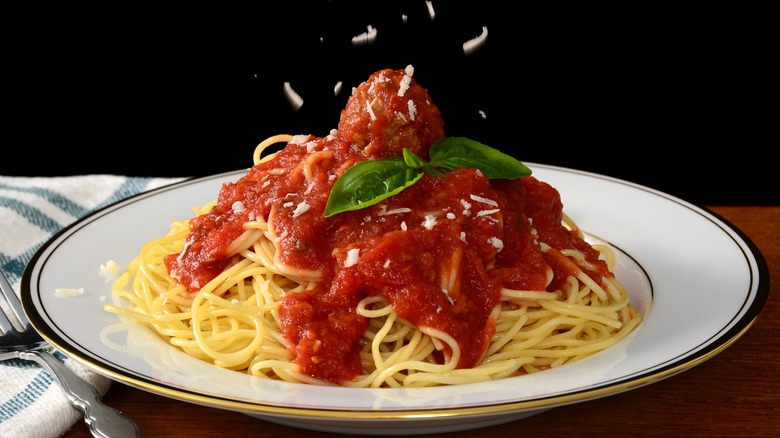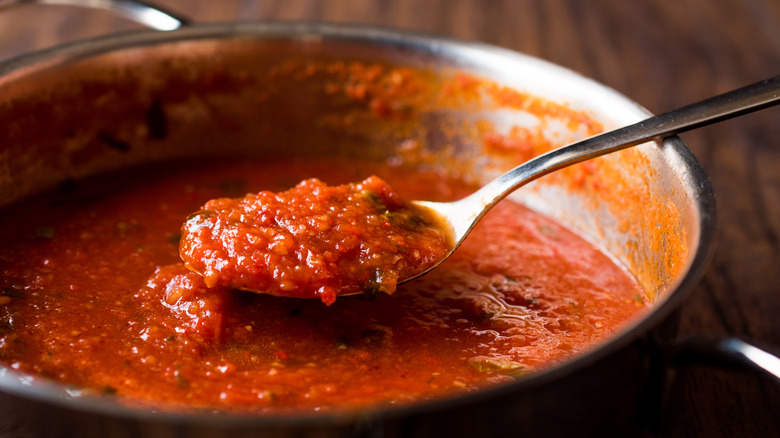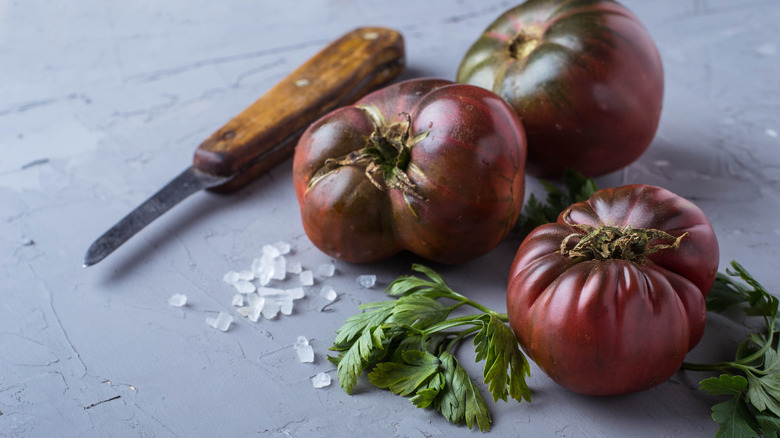The Smoky Ingredient That Elevates Basic Spaghetti Sauce
There are almost as many ways to upgrade tomato sauce as there are recipes for the sauce itself, but you may not have thought to add a hint of smoke for a uniquely savory depth. Blistering the tomatoes by cooking them in the oven is one way to achieve this, but there's an even quicker way to take your spaghetti sauce from so-so to smoky and flavorful. It starts with tomato paste.
Whether you're making your own sauce or you're trying to take a store-bought sauce up a notch, tomato paste in a can or a tube adds a concentrated and sweet-savory tomato flavor. Char the paste, though, and it takes on a smoky dimension that makes it even better. This process of caramelizing tomato paste is called "pincer" in French cooking.
Start by warming the tomato paste (along with a fat like olive oil) in a pan over medium heat. Cook the paste until it turns from red to a darker maroon or brick-red color. This should take only a few minutes, but make sure to stir constantly so the paste doesn't burn. You want some browned bits to form on the bottom of the pan but no black and burnt parts. The browning of the paste will concentrate the flavor while reducing that metallic "tinned" taste that some canned pastes may carry. However, going beyond the most basic form of this trick can yield even tastier results.
How to make the best charred tomato paste
Cooking tomato paste makes it so tasty due to the Maillard reaction. When you caramelize ingredients in a hot pan, this chemical reaction gives them concentrated, savory, and slightly sweet flavors while also creating delicious browned bits at the bottom of the pot. These bits are called "fond," and while usually associated with browning meats or vegetables, tomato paste creates its own smoky fond when you cook it. You can kick your recipe up even more by maximizing the fond created by the paste.
Firstly, you can sauté the aromatics in your recipe before adding the tomato paste to the pan. As you might guess, browning garlic or onions, in addition to the paste, creates more fond and adds more savory flavor to the finished sauce. However, garlic cooks quickly and can burn easily, so you might want to remove it from the pot once it's browned, char the tomato paste, then stir your aromatics back in before proceeding with your recipe.
Another great trick is to deglaze your pan with just a bit of liquid after the paste is done cooking. Water can be sufficient for deglazing, and you could use pasta water if you're aiming for a silky sauce, but for a richer flavor, consider using wine or stock. Deglazing ensures that every last bit of that tasty fond is dislodged from the pan and gets thoroughly mixed into the tomato sauce.
Other ways to jazz up pasta sauce with smoky flavor
Using tomato paste to take your sauce to the next level is relatively easy, but if you know that you love smoky flavors, you can put in a little extra effort. Firstly, if you're making a sauce from fresh tomatoes, try seeking out black or dark purple heirloom tomatoes. These tomatoes are prized for their earthy, slightly smoky flavor and low level of acidity. A more accessible addition is liquid smoke, but also consider using canned fire-roasted tomatoes in your sauce, which are easy to find.
As for spices, smoked paprika is a good pick, but you can also consider cumin. While you might be accustomed to using ground cumin in chili or taco seasoning, toasting cumin seeds amplifies their earthy and smoky flavor, adding depth to your sauce. You'll want to grind them after toasting, though, to avoid crunching on seeds in your spaghetti. Be sparing, as well, as cumin is powerful and can throw off the balance of flavors.
Finally, whether you're making a fresh sauce or amplifying the flavors of a jarred sauce, consider baking it by putting a pot in the oven instead of warming it up on the stove. As it bubbles and bakes, fond will form on the surface and sides of the pot. Use a wooden spoon to periodically scrape the sides and stir it into the sauce to take advantage of all of its smoky goodness.



